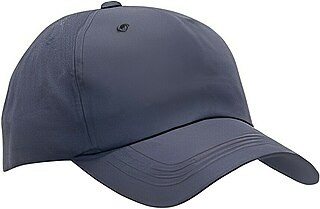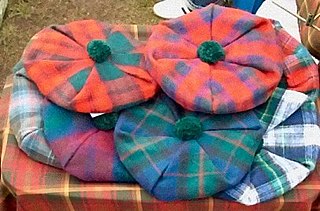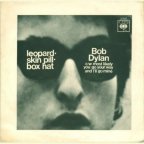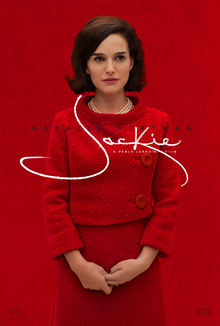
A pillbox hat is a small hat with a flat crown, straight, upright sides, and no brim. It is named after the small cylindrical or hexagonal cases that were used for storing or carrying a small number of pills. [1]

A pillbox hat is a small hat with a flat crown, straight, upright sides, and no brim. It is named after the small cylindrical or hexagonal cases that were used for storing or carrying a small number of pills. [1]
Historically, the pillbox hat began as a form of military headgear. During the late Roman Empire, the pileus pannonicus or "Pannonian cap", a type of headgear similar to the modern pillbox, was worn by Roman soldiers. A similar hat was popular with the Flemish in the Middle Ages. In the 19th century pillboxes were worn by the units of the British Army and its overseas possessions as well as by the Boys Brigade. In some countries, especially those of the Commonwealth of Nations, a pillbox-like forage cap, often with a chin strap, can still be seen on ceremonial occasions. The Royal Military College of Canada dress uniform includes such a hat, and similar caps were standard issue for the Victorian era British Army. Another cap called a kilmarnock is a modern version of the traditional headdress worn by members of virtually all Gurkha regiments. [2]

The modern woman's pillbox hat was created by milliners in the 1930s, and gained popularity due to its elegant simplicity. Pillbox hats were made out of wool, velvet, organdy, mink, lynx or fox fur, and leopard skin, among many other materials. They were generally designed in solid colors and were unaccessorized, but could include a veil. [1]
Jacqueline Kennedy, First Lady of the United States from 1961 to 1963, was well known for her "signature pillbox hats", designed for her by Halston, and was wearing a pink one to match her outfit on the day of her husband United States President John F. Kennedy's assassination in Dallas, Texas. [3] Actress Natalie Portman wore a pillbox hat to play Kennedy in the 2016 biographical drama Jackie . [4]
Pillbox hats are a satirical subject of the song "Leopard-Skin Pill-Box Hat" by Bob Dylan which first appeared on his 1966 album Blonde on Blonde . In 2013 hip-hop group Death Grips released a song entitled "You Might Think He Loves You for Your Money But I Know What He Really Loves You for It’s Your Brand New Leopard Skin Pillbox Hat". [5]

Natalie Portman is an Israeli-born American actress. She has had a prolific film career since her teenage years and has starred in various blockbusters and independent films, receiving multiple accolades, including an Academy Award and two Golden Globe Awards.

A baseball cap is a type of soft hat with a rounded crown and a stiff bill projecting in front.

A slouch hat is a wide-brimmed felt or cloth hat most commonly worn as part of a military uniform, often, although not always, with a chinstrap. It has been worn by military personnel from many different nations including Australia, Ireland, the United Kingdom, Canada, India, New Zealand, Southern Rhodesia, France, the United States, the Confederate States, Germany and many others. Australia and New Zealand have had various models of slouch hat as standard issue headwear since the late Victorian period.

A beret is a soft, round, flat-crowned cap, usually of woven, hand-knitted wool, crocheted cotton, wool felt, or acrylic fibre.

Bonnet has been used as the name for a wide variety of headgear for both sexes—more often female—from the Middle Ages to the present. As with "hat" and "cap", it is impossible to generalize as to the styles for which the word has been used, but there is for both sexes a tendency to use the word for styles in soft material and lacking a brim, or at least one all the way round, rather than just at the front. Yet the term has also been used, for example, for steel helmets. This was from Scotland, where the term has long been especially popular.

An ushanka, also called an ushanka-hat, is a Russian fur hat with ear-covering flaps that can be tied up to the crown of the cap, or fastened at the chin to protect the ears, jaw, and lower chin from the cold. An alternative way to wear is to bend the flaps back and tie them behind the head, which is called "ski-style" — this offers less protection from the elements, but much better visibility, essential for high-speed skiing. The dense fur also offers some protection against blunt impacts to the head. They are also traditionally worn in the Baltic region including Sweden, Finland, Norway and the whole eastern European region.

A tam o' shanter or "tammie" is a name given to the traditional Scottish bonnet worn by men. The name derives from Tam o' Shanter, the eponymous hero of the 1790 Robert Burns poem.

A bearskin is a tall fur cap, usually worn as part of a ceremonial military uniform. Traditionally, the bearskin was the headgear of grenadiers, and remains in use by grenadier and guards regiments in various armies.

A side cap is a military cap that can be folded flat when not being worn. It is also known as a garrison cap or flight cap in the United States, wedge cap in Canada, or field service cap in the United Kingdom; or in vulgar slang as a cunt cap. In form the side cap is comparable to the glengarry, a folding version of the Scottish military bonnet. It has been associated with various military forces since the middle of the 19th century, as well as various civilian organizations.

The peaked cap, peaked hat, service cap, barracks cover or combination cap is a form of headgear worn by the armed forces of many nations, as well as many uniformed civilian organisations such as law enforcement agencies and fire departments. It derives its name from its short visor, or peak, which was historically made of polished leather but increasingly is made of a cheaper synthetic substitute.

"Leopard-Skin Pill-Box Hat" is a song by American singer-songwriter Bob Dylan, which was released on the second side of his seventh studio album Blonde on Blonde (1966). The song was written by Dylan, and produced by Bob Johnston. Dylan has denied that the song references any specific individual, although critics have speculated that it refers to Edie Sedgwick, who Dylan had spent time with in December 1965.

The uniforms of the British Army currently exist in twelve categories ranging from ceremonial uniforms to combat dress. Uniforms in the British Army are specific to the regiment to which a soldier belongs. Full dress presents the most differentiation between units, and there are fewer regimental distinctions between ceremonial dress, service dress, barrack dress and combat dress, though a level of regimental distinction runs throughout.

A Karakul hat, sometimes spelled as Qaraqulhat, also called Uzbek hat and Jinnah Cap. It is a hat made from the fur of the Qaraqul breed of sheep. Karakul is directly translated as black fur in the Uzbek language and the hat originally comes from Bukhara. The fur from which it is made is referred to as Astrakhan, broadtail, qaraqulcha, or Persian lamb. The hat is peaked, and folds flat when taken off of the wearer's head.

The caubeen is an Irish beret, formerly worn by peasants. It has been adopted as the head dress of Irish regiments of Commonwealth armies.
A major American icon, Jacqueline Kennedy Onassis has been portrayed, alluded to, and referred to in many media in the popular culture from the 1960s and continuing into the 21st century.

Headgear, headwear, or headdress is any element of clothing which is worn on one's head, including hats, helmets, turbans and many other types. Headgear is worn for many purposes, including protection against the elements, decoration, or for religious or cultural reasons, including social conventions.

Jacqueline Bouvier Kennedy was wearing a pink suit when her husband, President John F. Kennedy, was assassinated in Dallas, Texas on November 22, 1963. She insisted on wearing the suit, stained with his blood, during the swearing-in of Lyndon B. Johnson that afternoon and for the flight back to Washington D.C. Jacqueline Kennedy was a fashion icon, and the suit is arguably the most referenced and revisited among her clothing items.

Jackie is a 2016 biographical drama film directed by Pablo Larraín and written by Noah Oppenheim. The film stars Natalie Portman as Jacqueline Kennedy. Peter Sarsgaard, Greta Gerwig, Billy Crudup, and John Hurt also star; it was Hurt's final film released in his lifetime before his death in January 2017. The film follows Kennedy in the days when she was First Lady in the White House and her life immediately following the assassination of her husband, United States President John F. Kennedy, in 1963. It is partly based on Theodore H. White's Life magazine interview with the widow at Hyannis Port, Massachusetts, in November 1963.

A cap comforter is a form of woollen military headgear originating in the British Army.
Notes